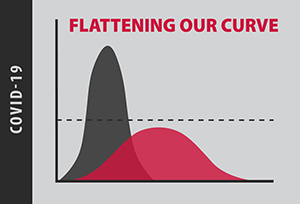We have three cases here and there will be more, but there doesn’t have to be a lot more. By keeping the number low, this will also have an impact on the region both economically and psychologically. In northeast Nebraska, more than 10,000 people commute in or out of the state for work and we have not been performing well with restricted travel. This imposes a risk in our community.
It is now a constant saying around the virtual water cooler these days: flattening the curve. By now most of us understand this means slowing the spread of the Coronavirus in order to protect our healthcare system and those at highest risk. But there is a lot of speculation out there about how to do this and how much will be enough.
As of today, March 30, we have 120 confirmed Covid-19 cases in Nebraska1, more than half of which are in the Omaha area. In northeast Nebraska , we have only 3 cases and they don’t seem to be increasing in a rapid manner. Though our relatively low population density may help us keep these numbers low, there is no reason to believe that we are free from the risk. Collectively, the states that surround Nebraska have a total of almost 4,000 confirmed cases. In our region, approximately 7,500 of our residents commute out of Nebraska for work and 6,200 commute here from out of state.2
In the past couple of weeks, our school systems have stopped congregating and all of our events have been cancelled. President Barrett at Northeast and President Rames at Wayne State have moved all credit courses online through the end of the school year and most non-credit courses have been cancelled. This means that more than 10,000 students from around northeast Nebraska are no longer coming together at central locations several times every week.
However, according to Unacast, a location analysis company, people in northeast counties are traveling just as much as they were before this crisis hit. In fact, 7 of the 20 counties have travelled more than what was typical before March 2020. To put it into context, the country has reduced travel by about 25%, Nebraska has reduced travel by 10%, and northeast Nebraska has decreased travel by 3%.
Our local public health departments are working hard on mitigation. Isolating these individuals and others known to have been in close contact with them is relatively simple, in theory. However, as we continue to come in contact with others, the disease will continue to creep through our society. As of this morning, Elkhorn Logan Valley Public Health Department reports that 99 residents within their jurisdiction have been tested (that’s 0.2% of that population).
So, the current train of thought among the epidemiologists is that we must participate in a combination of mitigation and suppression efforts. This means that we close down our schools and stay home from work. Evidence from the 1918 flu pandemic shows us that our efforts can work. The first graph shows how St. Louis was able to keep deaths below 75 per 100,000 people while Philadelphia waited to enact social distancing, resulting more than four times as many deaths.

How long do we have to stay separated? Many experts say that we need to wait for a vaccination (possibly 18 months3) or at least wait for a drug therapy (sometime between months and years4). The cost of releasing these constraints too early is another spike in cases. The next graph5 shows what happened in Denver during the 1918 pandemic. They relaxed too early, sent kids back to school, and ended the public gathering ban. A second wave of infections took hold and many lives were lost as a direct consequence.

I’m afraid that there is no easy way forward with Covid. It’s easy to look around and imagine that the virus isn’t here and won’t affect us. Unfortunately, if we act as though this is true, the infection will spread, some of our family, friends, and neighbors will get sick, and some may die.
The only constraints on this disease are the ones that we impose. There is no logical reason to believe that the lurking Coronavirus won’t follow the same trend here that we see elsewhere. Hopefully it will be slower. Hopefully warm weather will help (though its persistence in the southern hemisphere countries indicate that this is doubtful). Hopefully our efforts will keep it beyond arm’s length.
2 U.S. Census Bureau
3 https://www.imperial.ac.uk/media/imperial-college/medicine/sph/ide/gida-fellowships/Imperial-College-COVID19-NPI-modelling-16-03-2020.pdf
4 https://www.statnews.com/2020/03/24/when-might-experimental-drugs-to-treat-covid-19-be-ready-a-forecast/
5 https://jamanetwork.com/journals/jama/fullarticle/208354

